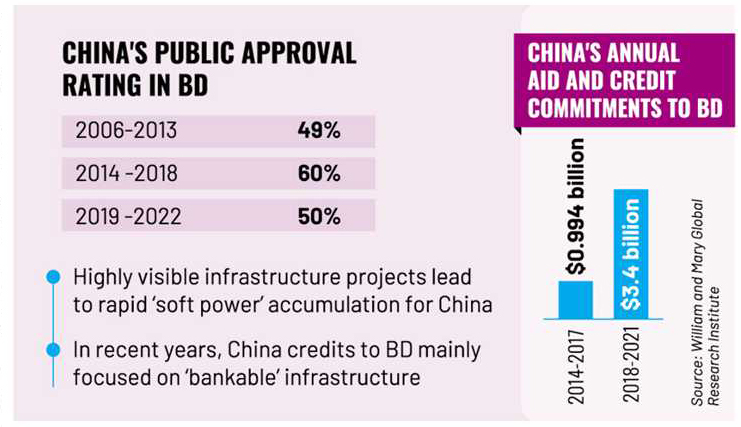
Global aid research report reveals
How Chinese aid advances BD dev, gains soft power
MIR MOSTAFIZUR RAHAMAN | Wednesday, 8 November 2023
China has gained popularity in Bangladesh through offering development-finance aid under its Belt and Road Initiative, reveals a global aid-research outfit about impacts of the BRI that hands out billions of dollars in credit.
However the research report, titled 'Belt and Road Reboot: Beijing's bid to De-risk Global Infrastructure Initiative', says in a footnote that gradually the public-approval rating is declining.
During the early BRI period, China made modest media-sentiment gains in Bangladesh at the expense of western countries like the US and the UK.

According to survey of the institute, public-approval rating in Bangladesh for China was 49 per cent between 2006 and 2013 and then it rose to 60 per cent in 2014-2018 period and came down to 50 per cent in 2019 -2022 period.
China dramatically increased aid credit to Bangladesh during the late BRI period as annual aid and credit commitments from Beijing to Dhaka was only $994 million between 2014 and 2017 but this figure soared to US$ 3.4 billion between 2018 and 2021, reads the report released Tuesday by the William and Mary Global Research Institute.
This "unprecedented increase in spending coincided with a period of political stability", the report notes.
Between March 1971 and December 2008 Bangladesh's largest foreign aid and credit providers were Japan, the United States and the United Kingdom. China did not maintain aid, especially large development finance programme, during this period. However, during the BR era, Beijing issued grant and loan commitments worth $17.5 billion, making it to the "single-largest development partner" of the country.
In 2006, China also surpassed India and the US to become Bangladesh's largest trading partner with $4.7 billion trade flow.
"One might assume that the combination of high trade volumes and unprecedented levels of aid and credit for highly visible infrastructure projects led to rapid soft power accumulation for China. However, in reality the relationship between developed and financial-support power has not been straightforward for several reasons," the report says.
According to the report, China's grant and loan commitments worth 20.8 billion US dollars for 138 projects in Bangladesh between 2000 and 2021 made the country one of China's 20 largest aid and credit recipients in the developing world and seventh- largest recipient in Asia.
China ODA and official finance commitments to the country soared from US$3.3 billion during the pre-BRI period, that is, from 2000 to 2013, to US$17.5 billion during the early and late BRI periods from 2014 to 2021.
The BRI project portfolio was largely focused on the construction and rehabilitation of power plants' transmission lines and bridges.
"Given the unprecedented scale of this financial commitments and the highly visible nature of the infrastructure projects undertaken during the BRI, it is not surprising that building has made some public opinion and media-sentiment gains," the report says.
In recent years, China credits to Bangladesh mainly focused on bankable infrastructure.
Beijing in recent years issued loan worth $697 million for a fertiliser factory and US$595 million for 3G mobile and national Internet broadband network up-gradation, power plants and an open-water treatment plant.
According to the research finding, the conventional wisdom that China dramatically scaled back its overseas lending commitments during the late period due to the Covid-19 pandemic and rising concerns about debt sustainability does not match in case of Bangladesh because during this period Beijing provided US$2.3 billion per year in new ODA aid, which enabled the country the rapid completion of high-profile projects such as Padma bridge, elevated expressway and several power plants.
"In the six-month period leading up to the December 2018 election Beijing approved $6.8-billion loan for big projects including the 1320MW Bashkhali coal-fired power plant which was financed by five Chinese creditors and one local creditor, Rupali Bank, through a US$1.78 billion syndicated loan," the report mentions, pointing out China's seriousness in helping the government in carrying out its development drives.
"During the same six-month period, Chinese state-owned companies began the implementation of six additional projects backed by financial commitments worth US$6.5 billion, including the 1320MW coal-fired power plant and the high-profile Padma bridge rail-link project," it says.
mirmostafiz@yahoo.com